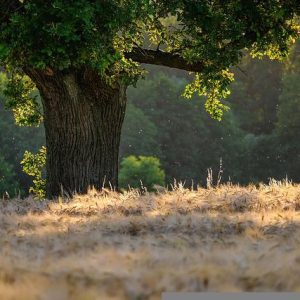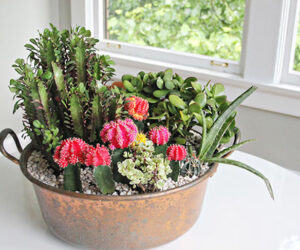When it comes to gardening, Arizona is a unique state. While the lower elevations offer more of a typical desert landscape, the higher elevations can be quite cool and lush. Because of this diversity, several plants will thrive in Arizona gardens – including trees!
Many different types of trees can flourish in an Arizona garden, but some are better suited than others. This article will take a look at six trees that will thrive in any Arizona garden. These trees provide shade, beauty, and privacy to any outdoor space. Let’s get started!
Southern Magnolia
The southern magnolia is a beautiful tree that can grow up to 80 feet tall. It has large, glossy green leaves and fragrant white flowers. This tree is popular in Arizona gardens because it is heat and drought-tolerant. Among the flowering trees to grow in Arizona, this tree offers one of the longest blooming periods, with flowers appearing from May to September. And with the incredibly fragrant flowers, they are also a great source of food for bees!
Additionally, the southern magnolia is known for its beautiful, dark green foliage. This tree provides a stunning backdrop for any garden. If you are looking for privacy, the southern magnolia is also a great option, as it can grow up to 30 feet wide.
There are also several hybrid varieties of the southern magnolia that have been developed specifically for Arizona gardens. These include the ‘Desert Magnolia’, which is a smaller variety that only grows to about 15 feet tall, and the ‘Tuscarora’, which has beautiful yellow-green foliage.
Mesquite
The mesquite is a hardy tree that is native to the desert Southwest. It can grow up to 50 feet tall and 30 feet wide, making it a great option for creating privacy in your garden. The mesquite has small, dark green leaves and produces small, yellow flowers in the spring.
This tree is drought-tolerant and can thrive in both hot and cold climates. It is also relatively low-maintenance, making it a great choice for busy gardeners. The mesquite is a slow-growing tree, so it will not require much pruning or trimming.
On the other hand, mesquite is not the best choice if you are looking for a flowering tree as the flowers are not very showy and they only bloom for a short period. Make sure to plant the mesquite in an area where it will not crowd out other plants in your garden.
Palo Verde
The palo verde is a beautiful small tree that only grows to about 15 feet tall. It is native to the deserts of Arizona, California, and Mexico. The palo verde has small, greenish-yellow flowers that bloom in the spring. This tree is also very drought-tolerant and can thrive in hot, dry climates. It is also relatively low-maintenance and does not require much pruning or trimming.
The palo verde is a great choice for gardens that receive a lot of Sun. It is also a good choice if you are looking for a tree that does not shed its leaves in the winter. Also, because the palo verde is a small tree, it is perfect for gardens with limited space.
However, the palo verde is not the best choice if you are looking for a tree with showy flowers. The flowers are small and not very noticeable.
Ironwood
The ironwood is a drought-tolerant tree that can grow up to 30 feet tall. It is native to the deserts of Arizona, California, and Mexico. The ironwood has small, greenish-yellow flowers that bloom in the spring. It also has dark green leaves that provide a beautiful backdrop for any garden.
Its name comes from the fact that the wood is very strong and dense. Ironwood is one of the heaviest woods in the world. This makes it a great choice for furniture or other projects where durability is important.
The ironwood is also a good choice if you are looking for a tree that does not shed its leaves in the winter. However, because it is a slow-growing tree, it may take several years to reach its full size.
Sycamore
The sycamore tree is a large, deciduous tree that is native to Arizona. It can grow up to 50 feet tall and has large, heart-shaped leaves. The sycamore tree is known for its ability to tolerate hot, dry conditions and is a popular choice for desert gardens. It is a perfect choice for creating shade in your garden.
The sycamore tree has large, white flowers that bloom in the spring. These flowers are very fragrant and attract bees and other pollinators. On the other hand, because it is a large tree, it will require regular pruning and trimming to keep it under control.
Make sure you have enough space in your garden before planting a sycamore tree! Sometimes, they can grow too large for their space and will need to be removed. However, it is an amazing tree if you’re looking for something that provides shade and is drought-tolerant, which makes a garden focal point.
Cottonwood
These trees are one of the best trees to plant in your Arizona garden. They are tall and provide plenty of shade, which is essential in the hot summers. They are also relatively drought-resistant, which is important in a state that often experiences drought conditions.
Cottonwoods can grow up to 50 feet tall and have light green leaves. They also have large, fluffy seeds that are carried by the wind. These seeds can be a nuisance for some gardeners, but they are an important food source for birds.
The cottonwood tree is a perfect choice for creating privacy in your garden. They are also a good choice if you are looking for a relatively low-maintenance tree. However, because they are such large trees, they will require regular pruning and trimming.

When choosing a tree for your Arizona garden, it is important to consider the climate and conditions of your area. Some trees are better suited for hot, dry climates than others. Make sure you choose a tree that will thrive in your garden and provide beauty and shade during the summer months.
Some of the most popular trees for Arizona gardens include southern magnolia, mesquite, palo verde, ironwood, sycamore, and cottonwood. Consider one of these trees for your next landscaping project!



